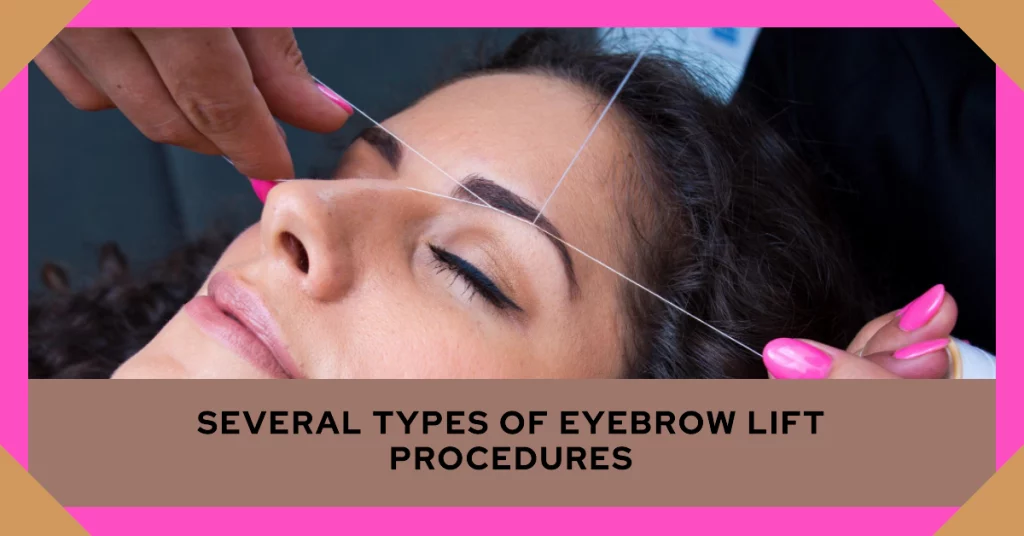An eyebrow lifting, also known as a forehead lift, is a cosmetic procedure that helps to raise and reshape the eyebrows, giving the face a more youthful and refreshed appearance. The procedure involves lifting the skin and tissues of the forehead and brow area to smooth out wrinkles and correct drooping eyebrows.
If you’re considering an eyebrow lift, it’s important to research the procedure and find a qualified and experienced cosmetic surgeon to ensure the best possible outcome. In this article, we’ll explore the various types of eyebrow lift procedures, risks, and step by step for doing eyebrow lifts.
What Does Eyebrow Lift Do?

An eyebrow lift, also known as a forehead lift, is a cosmetic surgery that can improve the appearance of the forehead and eyebrows by raising and reshaping them. As people age, the skin and tissues of the forehead can sag and droop, causing wrinkles and giving the face a tired or angry appearance. An eyebrow lift can help to correct these issues and give the face a more youthful and refreshed look.
There are different types of eyebrow lift procedures available, each with its own benefits and potential risks. Traditional forehead lifts involve making a long incision across the forehead, while endoscopic forehead lifts and temporal brow lifts are less invasive and require smaller incisions.
Several Types Of Eyebrow Lift Procedures

There are several types of eyebrow lift procedures, including traditional forehead lifts, endoscopic forehead lifts, and temporal brow lifts. The type of procedure recommended will depend on the individual’s specific needs and facial anatomy.
Traditional Forehead Lifts
Traditional forehead lifts involve making a long incision across the forehead, either at the hairline or in the natural creases of the forehead. The surgeon then lifts the skin and underlying tissues, removing any excess skin or fat, and suturing the incision closed. This technique is best suited for patients with more significant sagging and wrinkling in the forehead area.
Endoscopic Forehead Lifts
Endoscopic forehead lifts are a less invasive option that uses a small camera and specialized instruments to lift the forehead tissues through several small incisions. Using aesthetic medical equipment
this technique is often preferred for patients with milder sagging or those who want to avoid a more extensive surgical procedure.
Temporal Brow Lifts
Temporal brow lifts are another minimally invasive option that involves making small incisions in the hairline above the temple area. The surgeon then lifts and repositions the tissues to raise the outer portion of the eyebrows and smooth out wrinkles in the temple area.
How Long Does An Eyebrow Lift Last?

Regardless of the specific technique used, an eyebrow lift typically takes about 1-2 hours to perform under general anesthesia or local anesthesia with sedation.
The recovery period for an eyebrow lift can differ based on the complexity of the procedure, but typically, patients are able to resume their normal daily activities, including work, after one to two weeks.
While an eyebrow lift can provide significant cosmetic benefits, like any surgical procedure, it does carry some risks. These can include bleeding, infection, scarring, and nerve damage. It’s essential to discuss these risks and the potential benefits of the procedure with a qualified cosmetic surgeon before deciding to undergo an eyebrow lift.
Risk In Doing Eyebrow Lifts
As with any surgical procedure, there are some risks associated with an eyebrow lift. Some of the potential risks include:

- Scarring: Depending on the type of brow lift procedure, there may be visible scarring around the incision site. While most scarring will fade over time, some patients may experience long-term scarring.
- Infections: Any surgical operation has a small risk of contamination. Patients should follow all post-operative care instructions to minimize this risk.
- Nerve damage: The nerves that control the movement of the forehead and eyebrows are located in the brow lift area. If these nerves are damaged during the procedure, the patient may experience a temporary or permanent loss of movement in the forehead or eyebrows.
- Hair loss: In some cases, hair loss may occur around the incision site. This is typically temporary and will grow back over time.
- Hematoma: A hematoma, or a pooling of blood under the skin, may occur after the procedure. This can cause swelling and discomfort and may require further medical attention.
- Anesthesia risks: General anesthesia or sedation can cause complications, especially for patients with pre-existing medical conditions.
It’s important for patients to discuss these risks with their cosmetic surgeon before undergoing the procedure. A qualified and experienced surgeon will take all necessary precautions to minimize the risks and ensure the best possible outcome for the patient.
Summary
In conclusion, an eyebrow lift can be an effective way to improve the appearance of the forehead and eyebrows, giving the face a more youthful and refreshed look. With advances in surgical techniques, there are now several options available to suit a wide range of patient’s needs and preferences.
However, as with any surgical procedure, it’s crucial to thoroughly research the procedure and find a qualified and experienced cosmetic surgeon to ensure the best possible outcome.






